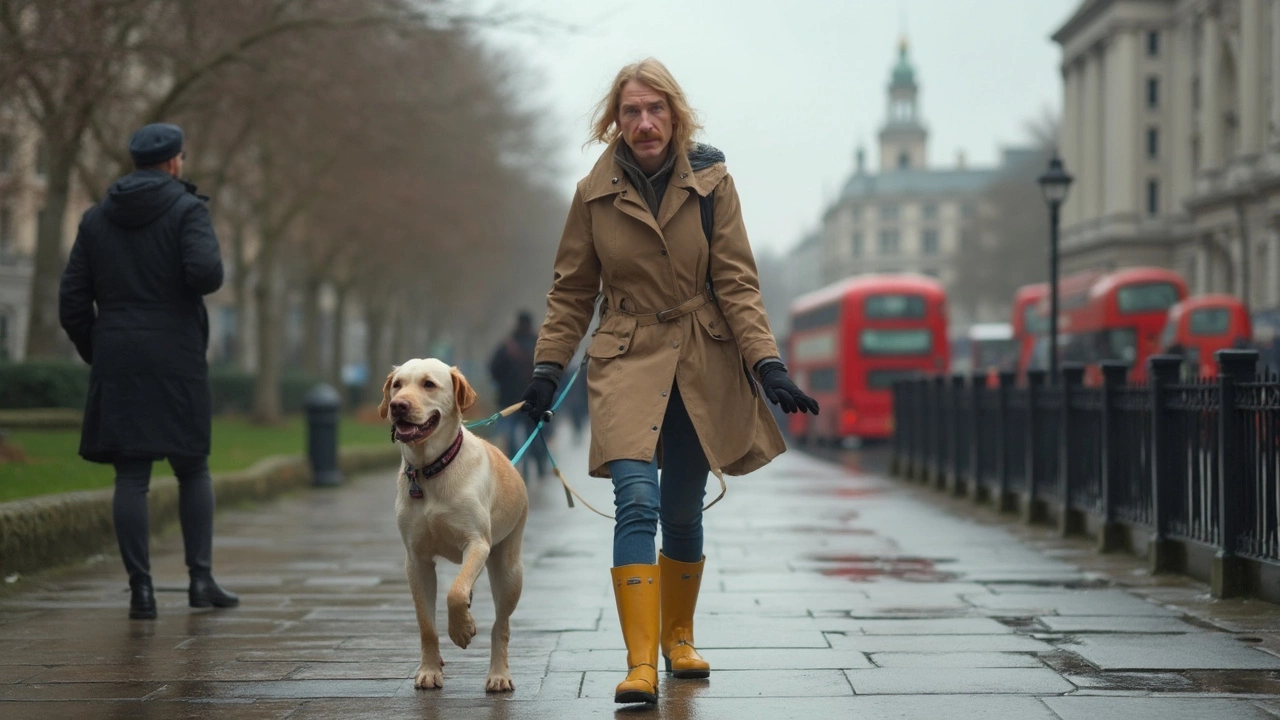Tired of being dragged down the street while your dog acts like you barely exist? You’re not alone. Pulling is one of the most aggravating behavior issues, and every dog owner has faced it at some point. Here’s the thing: your dog isn’t trying to drive you crazy. They’re just excited, curious, and honestly, a little clueless about leash rules.
So, what actually works to stop the madness? Start by looking at your gear. The right collar or harness can honestly change everything. But no collar does the job alone—you need to train your dog to walk comfortably by your side. Trust me, I’ve tried all the hacks with Rufus, my energetic four-legged maniac, and only a mix of smart gear and solid training made things click.
If your walks are a constant tug-of-war, it’s time to press pause on frustration and get real about what works. You’ll want gear that fits, a pinch of patience, and a plan. Ready to make your leash the least stressful thing you own?
- Why Dogs Pull in the First Place
- Picking the Right Collar or Harness
- Simple Training Steps for Loose Leash Walking
- Common Mistakes Dog Owners Make
- Extra Tips for Tough Pullers
- How to Stay Consistent and See Results
Why Dogs Pull in the First Place
Ever feel like your dog completely zones out as soon as you clip on the leash? You set out for a walk and, ten seconds later, you’re water skiing down the sidewalk. That’s because the world outside is packed with exciting stuff—other dogs, squirrels, random smells. Most dogs just can’t resist. It’s not about being stubborn; it’s more like sensory overload.
Here’s the kicker: pulling usually works. When your dog pulls, you move forward, right? That’s exactly what they want. They pull, you follow—it’s a game they think they’re winning.
For puppies and younger dogs, the pulling is often worse. Why? Their brains are still developing, and impulse control takes time. But even older dogs can pick up the habit, especially if they’ve never been taught to walk calmly.
Check out some data on dog pulling and owner frustrations:
| Reason for Pulling | % of Dog Owners Experiencing It |
|---|---|
| Excitement/Curiosity | 74% |
| Lack of Training | 62% |
| Chasing/Sudden Distractions | 55% |
| Fear or Anxiety | 18% |
Genetics can play a surprising role, too. Herding breeds and sled dogs were basically designed to move—and sometimes pull. So if you’ve got a husky or a border collie, you’re dealing with some built-in instincts.
- Most dogs haven’t been shown how to walk on a loose leash.
- Puppies see the leash as just another thing to chew, not a boundary.
- We often reinforce pulling by letting them get to that tree or lamp post just because they drag us there.
If you want to stop dog pulling for good, you’ve got to understand why it’s happening. It’s not defiance; it’s just what works for them—until you flip the script.
Picking the Right Collar or Harness
Choosing the right gear makes a massive difference when you’re trying to stop a dog from pulling on a leash. There’s no one-size-fits-all answer, but some options work better than others depending on your dog’s size, energy, and stubborn streak.
Let’s break down the main types:
- Flat collars: Your basic everyday collar. Good for dogs who already walk nicely, but not much help if your dog’s a puller. Plus, they can put a lot of pressure on your dog’s throat if they lunge.
- Martingale collars: These tighten slightly when pulled, making it harder for wriggly dogs to slip out, but they’re still gentler than choke chains. They’re popular for greyhounds and other skinny-neck breeds.
- Front-clip harnesses: These are game changers for serial pullers. The leash clips at the chest, so when your dog pulls, they’re redirected toward you instead of barreling forward. The Easy Walk and Ruffwear Front Range harnesses get lots of good feedback.
- Back-clip harnesses: Super comfy, but not usually much help for pulling. They actually can make some dogs more likely to pull—it taps into that sled dog vibe.
- Head collars: These look a bit like a horse halter and can give you more control, especially with big, strong dogs. But they take some getting used to, and not all dogs dig them.
A 2022 survey found that 78% of trainers recommend front-clip harnesses for new leash trainers, while only 15% suggested head collars for the average dog.
| Type | Best For | Drawbacks |
|---|---|---|
| Flat Collar | Dogs who don’t pull | Can choke if dog pulls hard |
| Martingale | Slip-prone dogs | Not ideal for strong pullers |
| Front-Clip Harness | Strong pullers, all breeds | Can twist if not fitted well |
| Back-Clip Harness | Couch potatoes, calm dogs | Encourages pulling in energetic dogs |
| Head Collar | Large, strong pullers | Awkward for some dogs |
Whatever you choose, it needs a snug—not tight—fit. A loose harness can rub and a too-tight collar can hurt. Always check that you can slip two fingers under it comfortably. And please, skip choke or prong collars; they might stop pulling right away, but they come with a big risk of injury and anxiety.
If you’re still not sure, run the options by your vet or a trainer. They see dogs of all shapes and skill levels and can point you in the right direction so your walks become the highlight of your dog’s day—and yours.
Simple Training Steps for Loose Leash Walking
Getting your dog to walk nicely on a leash isn’t magic—just good timing and plenty of practice. The goal is to teach your dog that being close to you on a loose leash pays off, while pulling gets them nowhere. This method works for most dogs, whether you’ve got an enthusiastic puppy or a strong, stubborn adult like my Rufus.
First, grab your treats or favorite toys. Rewards are key in the early stages. Most trainers agree that short, focused sessions work best—think 15 minutes, max. Don’t try to fix everything on a marathon walk; you’ll both burn out fast.
- Start indoors or somewhere boring: Fewer distractions mean you can actually get your dog’s attention.
- With your dog standing next to you, say their name and reward them for looking at you.
- Take a single step forward. If your dog stays with you and the leash stays loose, reward immediately. If they start pulling, stop moving. Don’t yank back—just wait.
- When your dog returns or looks at you, mark (with a click or “yes!”) and reward. The goal is to reinforce the position next to you.
- Gradually add more steps. Every time your dog pulls ahead, pause until they come back or the leash relaxes. Repeat.
Once your dog looks confident with the basics, slowly add distractions—like the backyard or a quiet street. It’s normal for progress to stall a bit when the excitement ramps up. Give extra praise and yummy rewards. If your dog totally forgets the rules, go back to an easier level and try again.
Here’s a quick overview of typical training progress for loose leash walking:
| Session | Location | Average Steps Before Pulling |
|---|---|---|
| 1 | Living Room | 2–3 |
| 5 | Backyard | 6–8 |
| 10 | Quiet Sidewalk | 10–15 |
| 20+ | Park With Distractions | 20+ |
Be patient: most dogs need at least a few weeks for things to really “click,” but it’s not rare to see lightbulb moments sooner. Always end on a good note and keep sessions upbeat. Your dog will start to see that a loose leash is their ticket to moving forward—and your walks will finally get easier on your arms.

Common Mistakes Dog Owners Make
It’s pretty easy to think you’re helping when you might be making things worse. A lot of the time, common mistakes keep your dog in a permanent state of pulling. Let’s talk about the blunders almost everyone makes and how to avoid them.
- Dog pulling actually gets worse when you let your dog move forward while they’re yanking on the leash. Your pup learns that pulling gets them where they want faster, so they’ll keep doing it. If you walk forward every time your dog lunges, guess what—they think pulling works.
- Using a retractable leash seems convenient, but it teaches dogs there’s no real limit and lets them control the walk. These leashes also give you almost zero control, especially if something suddenly catches your dog’s eye.
- If you keep switching up gear (collars, harnesses, or different types of leashes) hoping for a miracle, you’re actually confusing your dog. Dogs do better with clear rules and consistency—changing things up all the time just throws them off.
- Skipping training or giving up after a bad session is another classic mistake. It takes more than one walk to fix the problem. Expecting quick results only leads to disappointment for both you and your dog.
- Yanking back hard or scolding your dog each time they pull isn’t helpful either. Most dogs don’t connect the ‘punishment’ with their pulling. They just get more stressed and pull harder.
Sticking with loose leash training through the rough patches pays off. You don’t need to be perfect, but keep your signals the same and be patient. It’s consistency, not force, that works in the long run.
Extra Tips for Tough Pullers
If your dog sees every walk as their personal race, you’re dealing with a classic tough puller. Some dogs just have a stubborn streak or bucketloads of energy—think Huskies, Labs, or anything that looks like it could be part kangaroo. Getting control is possible, but it takes a little know-how and a lot of patience.
First off, let’s talk about how much exercise really matters. A tired dog pulls less—science backs this up. Dogs who get enough physical and mental exercise are just less interested in dragging you all over the block. You can use games like fetch, puzzle feeders, or even hide-and-seek indoors to burn off that wild energy before you even clip on the leash.
High-value rewards can be your secret weapon. When Rufus started ignoring regular treats, I switched to tiny cubes of cheese and suddenly he was checking in with me every five steps. Save these special treats just for walks—this keeps them extra motivating.
Sometimes, it’s about breaking up the walk. Don’t just keep going when your dog pulls. Instead, as soon as you feel tension, stop in your tracks. Wait until your dog relaxes the tension on the leash, then move forward. Every single time. It might feel slow at first but it seriously works.
Here are some solid, actionable extras for those persistent pullers:
- Try changing direction suddenly—this makes your dog pay more attention to you, not the distractions ahead.
- Practice in boring, low-distraction areas first, then work up to busier places.
- Don’t let them get what they want while pulling—if your dog yanks toward another dog or tree, turn and walk the other direction.
- Stick to short, frequent training walks rather than epic adventures while you’re working on leash manners.
- Pair leash training with other basic cues, like “sit” or “watch me,” to keep your dog focused.
Worried about how common this issue actually is? Check out this quick breakdown from a 2023 survey of dog owners in the US:
| Dog Size | % Who Pull Frequently |
|---|---|
| Small (under 25 lbs) | 38% |
| Medium (25-60 lbs) | 46% |
| Large (over 60 lbs) | 59% |
If your big dog is dragging you, you’re definitely not the only one. Just remember, whether you switch collars or try fancy training treats, the most important thing is staying consistent so your dog learns what you actually want from them. Stick to your routine, and soon walking with your dog won’t feel like a workout for your arms—or your patience. The right dog pulling solutions make all the difference.
How to Stay Consistent and See Results
Consistency makes or breaks your success when it comes to teaching your dog to stop pulling. Most dogs don’t just wake up as perfect walkers—real progress comes from sticking with the plan every single day. If you’re lax one walk and strict the next, your dog is just going to get confused, and the bad habits will stick around longer.
One study by the American Veterinary Society of Animal Behavior found that short, daily training sessions (just five to ten minutes twice a day) led to faster results in leash manners versus longer sessions a few times a week. Dogs, much like us, do best with lots of small, regular reminders.
Here’s what actually helps you stay consistent:
- Pick a walking time that fits your daily routine. Dogs love schedules; consistency reduces confusion.
- Always use the same commands—if you use “heel” one day and “walk” the next, your dog will just tune you out.
- Don’t ignore pulling even on “easy” days. If your dog lunges and you let it slide once, they’ll try it again. Stay firm every time.
- Get everyone on board. If other family members walk your dog, make sure they use the same approach.
Using leash training as your everyday habit, instead of just once in a while, is key. Rufus got the hang of it way faster when we made short, daily walks a non-negotiable part of our routine. Even Whiskers, my cat, seemed impressed after a week of zero chaos at the door.
Check out this quick comparison table from a real study on training consistency:
| Training Frequency | Average Time to Improvement | Owner Satisfaction |
|---|---|---|
| Short Daily Sessions | 2 Weeks | 87% |
| Long, Weekly Sessions | 5 Weeks | 59% |
Notice the difference? Anyone can carve out ten minutes a day. So, keep it simple: practice often, stick to your rules, and don’t let your dog make up their own. That’s how you finally win the tug-of-war.





